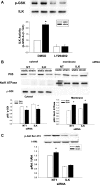ILK mediates the effects of strain on intestinal epithelial wound closure
- PMID: 21084641
- PMCID: PMC3043633
- DOI: 10.1152/ajpcell.00273.2010
ILK mediates the effects of strain on intestinal epithelial wound closure
Abstract
The intestinal epithelium is subjected to repetitive deformation during normal gut function by peristalsis and villous motility. Such repetitive strain promotes intestinal epithelial migration across fibronectin in vitro, but signaling mediators for this are poorly understood. We hypothesized that integrin-linked kinase (ILK) mediates strain-stimulated migration in intestinal epithelial cells cultured on fibronectin. ILK kinase activity increased rapidly 5 min after strain induction in both Caco-2 and intestinal epithelial cell-6 (IEC-6) cells. Wound closure in response to strain was reduced in ILK small interfering RNA (siRNA)-transfected Caco-2 cell monolayers when compared with control siRNA-transfected Caco-2 cells. Pharmacological blockade of phosphatidylinositol-3 kinase (PI3K) or Src or reducing Src by siRNA prevented strain activation of ILK. ILK coimmunoprecipitated with focal adhesion kinase (FAK), and this association was decreased by mutation of FAK Tyr925 but not FAK Tyr397. Strain induction of FAK Tyr925 phosphorylation but not FAK Tyr397 or FAK Tyr576 phosphorylation was blocked in ILK siRNA-transfected cells. ILK-Src association was stimulated by strain and was blocked by the Src inhibitor PP2. Finally, ILK reduction by siRNA inhibited strain-induced phosphorylation of myosin light chain and Akt. These results suggest a strain-dependent signaling pathway in which ILK association with FAK and Src mediates the subsequent downstream strain-induced motogenic response and suggest that ILK induction by repetitive deformation may contribute to recovery from mucosal injury and restoration of the mucosal barrier in patients with prolonged ileus. ILK may therefore be an important target for intervention to maintain the mucosa in such patients.
Figures









Similar articles
-
Role of RhoA and its effectors ROCK and mDia1 in the modulation of deformation-induced FAK, ERK, p38, and MLC motogenic signals in human Caco-2 intestinal epithelial cells.Am J Physiol Cell Physiol. 2011 Nov;301(5):C1224-38. doi: 10.1152/ajpcell.00518.2010. Epub 2011 Aug 17. Am J Physiol Cell Physiol. 2011. PMID: 21849669 Free PMC article.
-
Repetitive deformation activates Src-independent FAK-dependent ERK motogenic signals in human Caco-2 intestinal epithelial cells.Am J Physiol Cell Physiol. 2008 Jun;294(6):C1350-61. doi: 10.1152/ajpcell.00027.2008. Epub 2008 Apr 9. Am J Physiol Cell Physiol. 2008. PMID: 18400991 Free PMC article.
-
Delineating the signals by which repetitive deformation stimulates intestinal epithelial migration across fibronectin.Am J Physiol Gastrointest Liver Physiol. 2009 Apr;296(4):G876-85. doi: 10.1152/ajpgi.90648.2008. Epub 2009 Jan 29. Am J Physiol Gastrointest Liver Physiol. 2009. PMID: 19179620 Free PMC article.
-
Repetitive deformation activates focal adhesion kinase and ERK mitogenic signals in human Caco-2 intestinal epithelial cells through Src and Rac1.J Biol Chem. 2007 Jan 5;282(1):14-28. doi: 10.1074/jbc.M605817200. Epub 2006 Nov 6. J Biol Chem. 2007. PMID: 17088251
-
Focal Adhesion Kinase and Colony Stimulating Factors: Intestinal Homeostasis and Innate Immunity Crosstalk.Cells. 2024 Jul 11;13(14):1178. doi: 10.3390/cells13141178. Cells. 2024. PMID: 39056760 Free PMC article. Review.
Cited by
-
Hippo pathway in intestinal diseases: focusing on ferroptosis.Front Cell Dev Biol. 2023 Dec 6;11:1291686. doi: 10.3389/fcell.2023.1291686. eCollection 2023. Front Cell Dev Biol. 2023. PMID: 38130953 Free PMC article. Review.
-
Role of RhoA and its effectors ROCK and mDia1 in the modulation of deformation-induced FAK, ERK, p38, and MLC motogenic signals in human Caco-2 intestinal epithelial cells.Am J Physiol Cell Physiol. 2011 Nov;301(5):C1224-38. doi: 10.1152/ajpcell.00518.2010. Epub 2011 Aug 17. Am J Physiol Cell Physiol. 2011. PMID: 21849669 Free PMC article.
-
Intestinal mucosal atrophy and adaptation.World J Gastroenterol. 2012 Nov 28;18(44):6357-75. doi: 10.3748/wjg.v18.i44.6357. World J Gastroenterol. 2012. PMID: 23197881 Free PMC article. Review.
-
Platelet stimulation-regulated expression of ILK and ITGB3 contributes to intrahepatic cholangiocarcinoma progression through FAK/PI3K/AKT pathway activation.Cell Mol Life Sci. 2024 Dec 27;82(1):19. doi: 10.1007/s00018-024-05526-3. Cell Mol Life Sci. 2024. PMID: 39725790 Free PMC article.
-
Adiponectin suppresses stiffness-dependent, profibrotic activation of lung fibroblasts.Am J Physiol Lung Cell Mol Physiol. 2024 Oct 1;327(4):L487-L502. doi: 10.1152/ajplung.00037.2024. Epub 2024 Aug 6. Am J Physiol Lung Cell Mol Physiol. 2024. PMID: 39104319 Free PMC article.
References
-
- Arold ST, Hoellerer MK, Noble ME. The structural basis of localization and signaling by the focal adhesion targeting domain. Structure 10: 319–327, 2002 - PubMed
-
- Assi K, Mills J, Owen D, Ong C, St. Arnaud R, Dedhar S, Salh B. Integrin-linked kinase regulates cell proliferation and tumour growth in murine colitis-associated carcinogenesis. Gut 57: 931–940, 2008 - PubMed
-
- Basson MD, Li GD, Hong F, Han O, Sumpio BE. Amplitude-dependent modulation of brush border enzymes and proliferation by cyclic strain in human intestinal Caco-2 monolayers. J Cell Physiol 168: 476–488, 1996 - PubMed
Publication types
MeSH terms
Substances
Grants and funding
LinkOut - more resources
Full Text Sources
Molecular Biology Databases
Miscellaneous

